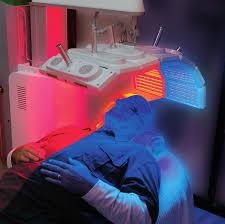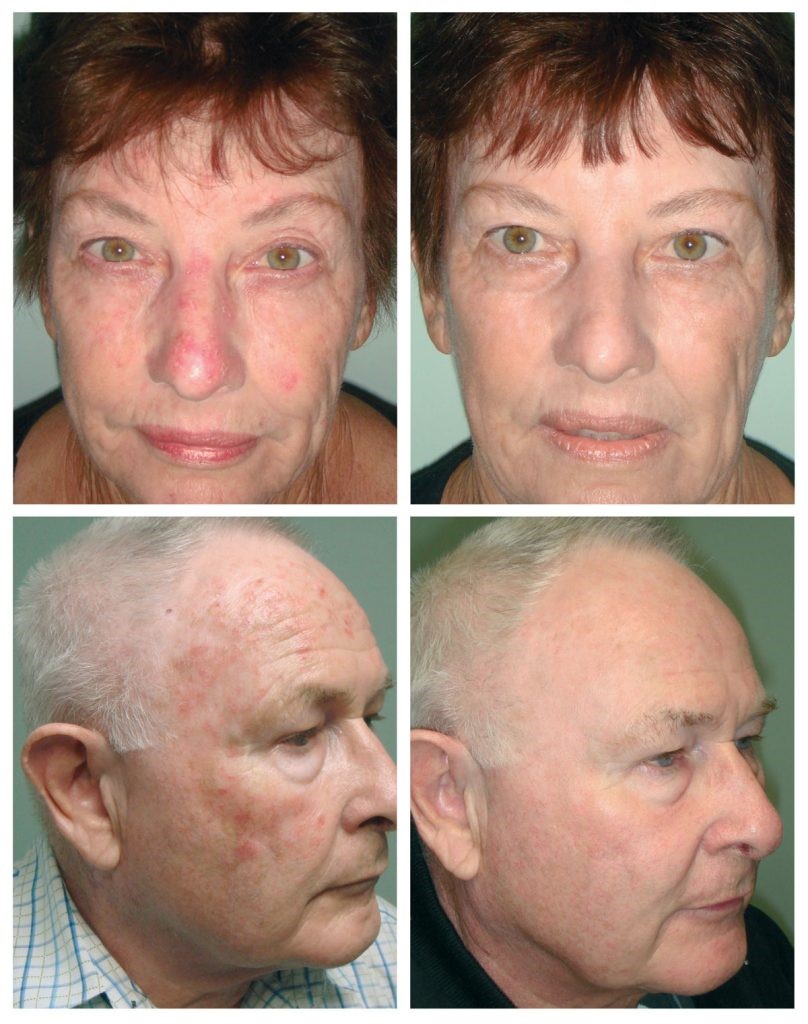What if there was a way of preventing skin cancers before they developed?
What if there was an alternative to having certain suspicious skin spots frozen off or cut out?
What if there was a preventive treatment for people prone to sun damage and non-melanoma skin cancers?
Well, there is a treatment for preventing skin cancer and it is called Photo Dynamic Therapy (PDT).
PDT involves a liquid with an active ingredient being applied to the skin where it absorbs and incubates for a set period of time (generally between 1-3 hours). During this incubation period the liquid selectively enters into sun damaged, pre-cancerous and cancerous skin cells. It does not enter the healthy skin cells. After the incubation time the skin is exposed to red and blue LED lights that cause the active ingredient to destroy the abnormal cells, while leaving the healthy skin cells alone.
PDT is a “field” treatment – it treats the whole area of skin. Generally, one area is treated per session, this may be the whole face, the scalp and forehead, or the forearms and hands. As the whole “field” is treated – not only do sun spots disappear, but areas in between that may be developing into solar keratosis or skin cancers in the near future are also treated. Thus it is also a preventive treatment for skin cancer.

Who is the ideal patient for PDT?
Anyone with sun damage spots (actinic or solar keratoses) will benefit from PDT. Anyone with a history of SCC or BCC skin cancers should consider PDT as a preventive measure.



(Dermnet images of Sun Damage / Actinic Keratoses)
Does PDT work for:
SCCs and BCCs? (Non-pigmented skin cancers)
Yes, small BCCs and SCCs can be treated with PDT. Larger ones will need excision. After excision if the margins are positive (small amounts of cancerous cells may have been left behind) then PDT may be an appropriate treatment rather than an excision.
Solar or actinic keratosis? (Sun damage spots)
Yes, these are the ideal lesions to treat with PDT. The PDT will not only treat the actinic keratosis patches but also catch any cells in between that are starting to form actinic keratosis but not to the extent they are visible yet.
Melanomas?
No, any lesion suspicious of being a melanoma should not be treated with PDT. It is important these lesions are excised. You need to have a full skin check with a doctor prior to PDT to check your skin lesions are ideal for treatment with PDT rather than other methods.
Is it painful?
When the red and blue lights are applied you will feel a tingling or prickly sensation. This can vary from mild to quite severe. Our Dermal Clinician will sit with you throughout the entirety of your treatment, applying cooling spray and fans in order to make the session as comfortable as possible. The treatment settings can also be adjusted depending on your tolerance. The LED light settings at Geelong Veins Skin & Laser are very precise, causing the right amount of cell destruction with the least amount of discomfort compared with other LED lights.
After the treatment you will have redness and discomfort of the skin. This is an expected side effect. If there is no discomfort in the following days then the treatment has not worked sufficiently.
What is the downtime?
This is a treatment where you need to plan and modify your activities in the following week. Immediately after PDT you need to return home or to an indoor location away from sunlight and bright synthetic lights for the remainder of the day. You will need to wear a hat and veil and/or gloves to cover all treated areas of skin.
For at least 7 days after PDT you should expect some degree of redness, swelling and peeling skin. Many patients will take time off work to recover. A doctor’s certificate can be issued if necessary.
What is the preparation?
You will need to attend Geelong Veins Skin and Laser approximately 2 weeks prior to your PDT to discuss the treatment with one of our dermal therapists and learn about skin preparation prior to PDT.

Who will I see for my appointment?
A full skin check with one of the doctor’s at Geelong Veins Skin and Laser is recommended prior to booking PDT. It is important to diagnose your skin lesions accurately and check they are appropriate for PDT. You will then see our highly trained dermal therapists for the pre consultation and the Photo Dynamic Therapy. You will then have a follow up appointment made with the initial skin doctor you have seen to check for full resolution of your skin lesions at around 4 weeks post treatment.
PDT results

Image – c/o Allmedic
Was this page helpful?
 Share
Share



